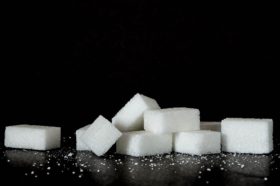
The first intended purpose for these products is exfoliation, or the removal of the dead, keratinized skin cells from the epidermis (outer layer) of the skin. The second stated purpose is that sugar is a natural humectant, meaning it supposedly draws moisture from the environment into the skin to keep it moisturized. The third reason I found for using these is, sugar scrubs (and chemical peels) often contain glycolic acid, which is a form of alpha hydroxy acid that penetrates the skin and dissolves skin cells, encouraging the production of new cells (cellular turnover). This is a general type of skin treatment which is also commonly described (using various chemicals) as a “chemical peel”.
When I was first researching about these types of products, the two questions that came to my mind were: 1. Are these actually beneficial or useful? And 2. Do they really have the desired effects that are claimed? For example, these products are claimed to make skin appear more youthful by removing the outer layer of skin. But what (long term) unintended health consequences might these have on the underlying dermal tissue (the deeper layer of skin with living skin cells)? The more research I did, the more I realized that the latter question was important to address.

The “conventional wisdom” regarding these types of products is that these are perfectly safe. However at Nature’s Complement we have never been ones to blindly accept conventional wisdom without verifying it for ourselves. We’ve always thought that part of the value proposition that we provide to our customers is to “think outside the box” of conventional “wisdom” of skin care products. In writing this article we made use of our biomedical research experience, our knowledge of biology and chemistry, and some of our health care experience, to provide a very much outside the box perspective on this topic. We hope these ideas are useful to people in helping to reduce real, actual skin aging, through proper care of your skin, with longevity in mind.

Cellular Physiology Process Number One
There are two key cellular physiology processes that play roles here. The first is cellular turnover. Almost all cells in the human body (with very few exceptions) have a limit to the number of times they can divide and make new cells. This limitation has been called the “Hayflick Limit” and it is caused by the shortening of the DNA at the tips of our chromosomes known as telomeres (pronounced teelo-meers). Due to the chemistry of the molecular machinery involved in replication of our DNA, each time a cell divides and duplicates its DNA, a small amount of telomeric DNA at the end is lost. When the DNA at the ends of our chromosomes (telomeres) become too short, cells will stop dividing and become senescent. Senescence is sort of like a form of cellular retirement. In short, once cells stop dividing (or cease to be able to divide any more) into new cells, you are left mainly with aged (senescent) cells. This is what results in many pathologies of aging, including wrinkles.

To put this in context of chemical peels and sugar scrubs, every time you peel or scrub off a layer of skin and force the underlying dermal cells to replicate, your cells lose some telomeric DNA and they become one generation closer to senescence. In other words, by doing this you speed up the skin aging process by forcing your cells to divide, thus shortening your cells’ telomeres. If you want to keep youthful skin, this is exactly the opposite of what you want to accomplish. Cells with longer telomeres are literally more youthful.
This process of inducing skin cellular turnover may keep your skin looking good in your younger years, but it will cause accelerated skin aging that will definitely become noticeable in your middle or later years. You skin will look older than it should at a given age. The only (and I mean only) way to solve this problem of senescent cells is to make the DNA at the ends of our cells’ telomeres longer again. However, telomeres do not get longer naturally, so medical intervention would be required to accomplish this. Currently there are drugs in development to do this, yet none are commonly available. So, while chemical peels and sugar scrubs may keep you looking young now, they will certainly make you look older later.

Cellular Physiology Process Number Two
The second cellular physiology process related to sugar scrubs is known as “non-enzymatic glycosylation”, also known as “glycation”. Glycosylation, simply defined, is when a sugar molecule undergoes a chemical reaction where it becomes bonded to some tissue made of proteins and/or lipids. Enzymatic glycosylation, is a normal process where human enzymes intentionally bind sugar to a cell (usually the cell surface), for some purpose, such as cellular identification or cellular signaling. Since enzymatic glycosylation was caused by an enzyme, it is reversible because it can also be undone by a different enzyme.
However, in the case of non-enzymatic glycosylation/glycation, the sugar binds to the protein or lipid via a different chemistry process that does not involve the use of an enzyme. This type of glycosylation is not normal for the body, and often leads to dysfunctional or damaged cells (known as Advanced Glycation End products or AGEs). This type of glycosylation is also not reversible without the use of certain drugs or nutrients that have been shown to do exactly that.
An analogy may help here. A commonly used analogy to explain oxidative damage is when an apple is cut open and it turns brown. The oxygen in the atmosphere causes oxidative damage to the unprotected apple cells on the exposed surface (technically by ripping away electrons). Along a similar line, when you put a sugar baste on a turkey and bake it in the oven and it turns brown, that is one type of non-enzymatic glycosylation/glycation reaction. The sugar molecules are binding to the proteins and lipids of the turkey, and that process is largely irreversible. (For health reasons you may also reconsider eating sugar-browned foods such as this, as it is unknown if the human body can break down consumed AGEs).

One type of human pathology that involves non-enzymatic glycosylatoin/glycation is diabetes. If you are a diabetic, or know someone who is, you may have heard that they need to have their “A1c” or “glycated hemoglobin” tested to make sure it is not too high. This is basically a measure of the percentage of red blood cells that have been damaged by sugars binding to them in an non-enzymatic and non-functional way – exactly what we are talking about here. Diabetics are known in the medical community to develop numerous secondary pathologies, many of which can be attributed to glycation. It is also worth noting that diabetics with poor blood sugar control are known to have poor skin wound healing. Here is one study among many showing exactly that. And interestingly, even mobility problems have been associated with collagen glycation damage.
So what does this have to do with sugar scrubs? Well I’m glad you asked, as it gets me back on topic. As the name implies, sugar scrubs involve the use of, yes, sugar. Since concentrated sugar exposure can play a causative role in non-enzymatic glycation, I pose the question “Is that really something to which you want to expose your skin?” Let me backup and qualify this. Exposing the epidermis or outermost layer of skin probably shouldn’t make that much difference, as the outermost layer of skin is largely made up of “dead” keratinized cells, so there is little concern about glycation adversely affecting living cells.

However, since the main point of sugar scrubs is specifically to remove much of the outermost layer of skin to expose living skin cells, then underlying living skin cells (fibroblasts and keratinocytes) will be exposed to high concentrations of sugar (and this is certainly not natural). But will such exposure cause any actual harm such as glycation? I don’t know, but neither does anyone else. As far as I could find, no one has ever studied what affects sugar exposure has on living skin cells or tissue. This is not surprising, as there is little incentive for anyone to spend money on such research (either experimental or epidemiological). However I did find one study showing that Advanced Glycation End products play a role in (skin) psoriatic plaques.

There is also a lot of evidence in the medical literature that high concentrations of sugar do bad things to numerous other cell types. This includes nerve cells in diabetic neuropathy, epithelial cells in atherosclerosis, or the numerous kidney cell types that develop nephropathy due to sugar in urine. So why would we assume there are no adverse effects to skin cells? Admittedly, this portion of this article is speculative in nature, and I admit that. But I have not seen anyone else put together the puzzle pieces of what harm sugar scrubs may be doing to people’s skin in the long run. The absence of studies on the effects of sugar scrubs on skin does not automatically mean they are safe or that there is no harm. Scientists have a saying: “absence of evidence does not mean evidence of absence“. As with many things, sometimes the damage is unknown for years until it is too late.
So what are my bottom line thoughts on chemical peels, sugar scrubs, and ex-foliation? Unless you have some rare special event such as something like wedding photos, or you have a dermatological medical condition such as keratosis, I would not recommend using chemical peels or alpha hydroxy acid, as they will shorten the lifespan of your skin cells. In other words, rare use might not be too destructive, but regular, or even semi-regular use will be. Your skin cells will wear out before you do.
I would avoid sugar scrubs entirely (they are not necessary), and if you feel that exfoliation is necessary due to a build up of dead dry skin, then use something else like a cloth, a soft brush, or a course soap like our oatmeal soap.
On the topic of exfoliation, this article has some additional good advice.
If you want a humectant effect, I recommend you try our La Rosè lotion as it provides exactly that.
Sugar scrubs and chemical peels are most likely not doing your skin any long term favors.
EDIT: We have had requests for more scientific references on this topic. I have included a (partial) list of references below, primarily related to the first half of this article (chemical peels). In the future I will add references regarding the second half of this article (sugar scrubs).
For Health,
Rob
Handbook of the Biology of Aging (Eighth Edition) 2016, Pages 205-239.
Ting-Lin B.Yang, Shufei Song, F. Brad Johnson
https://www.sciencedirect.com/science/article/pii/B9780124115965000071
Nature's Complement is a participant in the Amazon Services LLC Associates Program, an affiliate advertising program. If you purchase products on Amazon through any of our affiliate links, we get a small percentage of the transaction, at no extra cost to you. We spend a lot of time writing the articles on this site, and all this information is provided free of charge. When you use our affiliate links, you support the writing you enjoy without necessarily buying our products. (However we would appreciate if you would do that too!) Thank you for helping to support our work, however you choose to do so.
These statements have not been evaluated by the Food and Drug Administration. This information and/or products are not intended to diagnose, treat, cure or prevent any disease.



Hi, as a monthly user of Chemical Peels at a clinic which is lead by a Doctor and specialist in Cosmetic Medicine, I felt there was value in sharing with you his response after I sent him a link to your article. I did so because I had some concerns about whether I was doing the right thing, for me and my skin, by having these regular peels, and here is his response to your article.
Kind regards
Therese
Our response to this Doctor’s comments below:
Hello Therese,
Thank you for your interest, and you are right to be concerned. As you mentioned in your follow up email, I’m sure there are many others who are concerned about this also.
What concerns us is that your Dermatologist or other skin Doctor has a key misunderstanding about skin aging, the nature of cellular senescence and cellular aging, and/or ignores a key point of our argument. Therefore his analogies are not appropriate nor correct. He is making justifications for a bad practice, and I explain why below.
The key question that needs to be answered is “what causes skin aging and how does that work?”, and then everything else becomes clear from there. As your Doctor admitted, skin cells, like all cell types that divide frequently, eventually reach cellular senescence or the Hayflick limit. This means there is a limit to the number of times that your skin cells can divide. Your Doctor used the analogy of comparing skin cells to exercising muscles in a gym, but there is a key error here because these work by entirely different physiological mechanisms. Muscles get bigger by a process known as “hypertrophy” – meaning muscles get bigger by growing the size of existing cells larger. Muscles do not get bigger as a result of cellular division (also known as “hyperplasia” in muscles, or “mitosis” in other cell types). Muscles get bigger or smaller by adding or subtracting proteins through a process known as “treadmilling”. This is not how skin is maintained. Skin is maintained through cellular division. Because skin growth and maintenance, and muscle growth and maintenance, are two completely different types of processes, the analogy your Doctor used is incorrect and inappropriate.
A much better analogy for skin cells is the number of times they are able to divide is like a fuse on a bomb – each time a cell divides the fuse gets a little shorter. This “fuse” in cells is know as a “telomere”. Telomeres are a special type of DNA that comprise the ends/tips of the rest of our DNA in our cells. Unlike most of our DNA, telomeres do not contain genes. Telomeres protect the rest of our DNA from getting damaged. So when telomeres get too short, it initiates cellular senescence to prevent cells from dividing further, which would damage DNA that does contain genes. Cells that divide after their telomeres get too short often become cancerous. So instead, cells with short telomeres basically just shut down or die off (through a process known as apoptosis). But eventually you run out of cells that can still divide. When you have a lot of cells that reach senescence and can no longer divide, that is what causes the signs of aging like wrinkles and gray hair.
So when glycolic acid is applied to your skin, as your Doctor admits, it causes cellular turnover or cellular division. As I explained, each time a cell divides, its telomeres get shorter. So by using chemical peels, you are accelerating telomere shortening, and thereby accelerating skin aging. In the long run it will make skin cells reach senescence faster. So later in life you will have more aged skin. This is not speculation, this is strongly supported by the numerous studies I provided. Your Doctor argues that this accelerated turnover is a temporary process, which is technically true. But to go back to my fuse analogy, normally the fuse may be burning slowly, but when you use chemical peels your are accelerating the rate that the fuse burns (albeit temporarily). This makes you reach the endpoint that much faster because you are only born with a certain length of telomeres. Every time a cell divides its telomeres shorten. So by forcing cell division, you are essentially accelerating the shortening of telomeres and accelerating the rate of aging and the rate at which cells will become senescent. Such accelerated turnover does matter. So in the long run this procedure definitely does cause harm and definitely does accelerate skin aging. Because at this time, there are no known methods for re-lengthening telomeres in skin cells, though researchers are trying to do just that. I am extremely certain of all this, as I have spent years researching this topic in the lab.
Your Doctor wrote: “So, if after an initial phase of increased cell turnover your epidermal cells return to a normal degree of turnover, maintaining the new level of epidermal thickness, the whole telomere/Hayflick limit problem no longer exists.”
This is completely incorrect, and shows that your Doctor does not understand modern cellular and molecular physiology of how skin cells age. Returning cellular turnover to baseline only means that the rate by which the fuse is shortening has returned to a slow burn rather than a fast one. That definitely does not mean that the “Hayflick limit problem no longer exists”. The problem is always a consideration, it’s just a matter of how fast you are reaching the problem. So it is aging your skin faster. As stated earlier, each individual is born with a certain length of telomeres, and there is currently no known way to lengthen them. So if you intentionally speed up the process of cellular turnover, you are intentionally speeding up the shortening of telomeres (and aging), as telomeres shorten every time your (skin) cells divide.
Similar problems apply when analyzing your Doctor’s analogy about exercise and free radical generation. Since we live in an oxygen rich environment, human cells have strong mechanisms for quenching free radicals to prevent damage – for example the potent endogenous antioxidant Superoxide dismutase (SOD). Human cells have very little to no ability (depending on cell type) to make telomeres longer. Skin cells normally have no ability to maintain or re-lengthen telomeres. Which means they normally have no way to increase the absolute number of times they can divide. They have no way to make the fuse longer. So again, because the physiological mechanisms are very different, that analogy is also flawed and is inappropriate.
In your more recent email you wrote: “The one particular item of interest to me in the article about the negatives of chemical peels was “about the life span of a cell”. So to answer this concern: by using chemical peels your are accelerating the loss of a cell’s telomeres, which means your are definitely shortening the absolute life span of each affected cell, because they can only divide so many times based on the length of the telomeres. When they run out of telomeres, they can no longer divide. This shortens the lifespan of the cell. This is very straight forward, and is very well documented in the scientific literature.
Your Doctor also wrote: “As an aside, the article you have sent easily moves from supposition to definitive advice. So, on the basis of supposition and speculation he moves almost imperceptibly to statements like “it will cause accelerated skin aging that will definitely become noticeable in your middle or later years”. This statement is based on zero clinical evidence, and mere undergraduate theorising.”
That statement only shows that your Doctor does not understand telomere biology and how skin cells actually age. There are numerous studies (which I have provided that were not Wikipedia articles) which support this conclusion. Your Doctor accused me of quoting Wikipedia articles and not real science. I only refer to Wikipedia for definitions for lay people who may not be familiar with basic concepts. I did also include very relevant peer reviewed studies from NCBI (18+ additional peer reviewed studies at the end of my article). Your doctor attacked my knowledge yet provided zero studies to support his statements, and expects me to accept his statements as fact simply because he has the MD label behind his name. I may not have an MD label, but I am a research scientist, and I can always provide studies to back my statements and arguments.
As an aside, the letters after a person’s name (MD, PhD, MS, BS) are not a good indicator of how much or little they know. I have found that how much someone knows is determined by how much they are willing to learn on an ongoing basis as science advances, rather than what they studied on a one time basis. Doctor’s have a license and a practice to defend because their livelihood depends on it, so investing time in proper research is not practical for them. So instead they do the best they know how with the knowledge that they have, even if it is outdated. If you want cutting edge science, don’t ask a clinician, ask a research scientist. Clinicians don’t have time to keep up with the research literature.
In this case, while there are numerous studies that strongly support the information provided in my original article, in reality, a clinical trial exactly as your Doctor suggests has not been conducted. The key difficulties to properly conducting such a clinical trial are 1. that humans live a long time, so the study would take 20-30 years to conduct, 2. The cost associated with such studies would have a low return on investment due to the length of the study, so finding someone to invest in such a study would be difficult, and 3. there would be ethical and practical difficulties of excluding confounding variables (how do you maintain equal skin exposure to things like UV light and toxins?) So the evidence that your Doctor requires to be convinced is near impossible to acquire, and unfair in the fact that he is not required to provide the same type of long term clinical trial results to show that his treatments do not harm the skin in the long term as he is claiming. He is therefore operating on a double standard. (The limited clinical safety trials on chemical peels have all been short term trials.) The difference here is that he uses his MD label to make statements as facts, while I use research studies to support what I say.
As per your Doctor’s request, I have provided a long list of peer reviewed scientific research papers that support my argument. I am trained as a research scientist, and I worked in pharmaceutical research and development, including pharmaceutical toxicology testing, for well over a decade. I can always support my arguments with extensive research evidence. So your Doctor’s comments were based on inappropriate and inaccurate assumptions. Why did your Doctor not provide peer reviewed scientific research evidence to support the long term safety of chemical peels? Probably because no such research exists?
While it is true that we are selling products, our goal is not to get rich from selling products, but rather to provide healthy alternatives which we also use ourselves. Your doctor is obviously also trying to sell a service, so it seems logically inconsistent for him to criticize us for selling something. The difference is we have provided published, peer reviewed, scientific research evidence that chemical peels are harmful, while your Doctor has not provided any such evidence to support that they are safe in the long term. We would be glad to evaluate any such evidence he may provide.
Please have your Doctor read our response and further explanation. I would be glad to discuss this with him further, at his convenience.
Kind Regards and For Health,
Rob